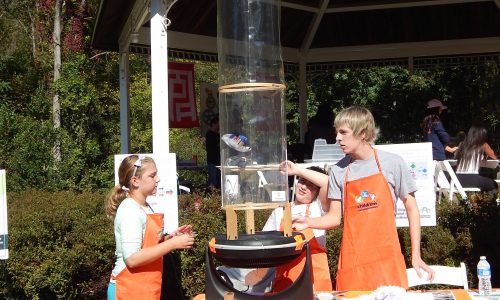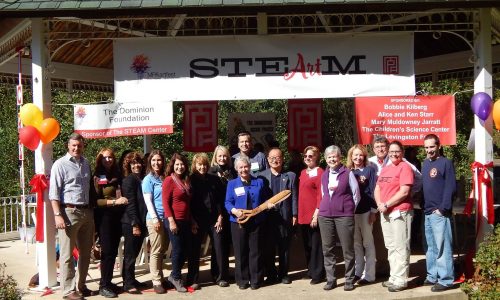

What is STEAM?
STEAM is a cross-disciplinary framework for teaching real-world problem solving – it fosters connection and intersection of subjects, with Art and Design as an equal player. It is also becoming more widely adopted in education initiatives and schools locally and nationally, as it is customizable and adaptive to curricula.
“What STEAM means, it should feel like Steve Jobs, what he did for America…It’s an innovation strategy for America.” -John Maeda, past president of the Rhode Island School of Design STEAM: Experts Make Case for Adding Arts to STEM (December 2011)
Art education teaches the flexible thinking and risk taking that are needed in today’s complex and dynamic world. Integrating Art + Design into STEM education promotes critical thinking, a key 21st Century skill.
Artists and scientists both ask big questions; designers and engineers both provide inspired solutions. Together they are more powerful than apart.
Adding Art + Design to STEM research will enhance U.S. economic competitiveness.
See more at http://stemtosteam.org/take-action/
STEAM Experts Link Learning with Art
“With global competition rising, America is at a critical juncture in defining its economic future. I believe that art and design are poised to transform our economy in the 21st century in the same way that science and technology did in the last century, and the STEAM movement is an opportunity for America to sustain its role as innovator of the world.” – John Maeda, STEM to STEAM: Art in K-12 Is Key to Building a Strong Economy (October 2012).
“Arts improve academic performance. Students with an education rich in the arts have higher GPAs and standardized test scores, and lower drop-out rates—benefits reaped by students regardless of socio-economic status. Students with 4 years of arts or music in high school average 100 points higher on the verbal and math portions of their SATs than students with just one-half year of arts or music.” – Americans for the Arts, based on the latest research measuring the impact of the arts and arts education
Lisa Phillips is an author, blog journalist, arts and leadership educator, and has written about how the STEM to STEAM initiative channels the arts and promotes further skills related to life and academic success. Read Top 10 skills children learn from the arts – Washington Post
Her book “The Artistic Edge: 7 Skills Children Need to Succeed in an Increasingly Right Brain World”
Her blog post 6 Reasons That The Arts Are The Ideal Vehicle To Teach 21st Century Success Skills
Educational Leaders Support STEAM
“The STEAM Project will inspire and engage all students through rigorous project-based inquiry, interdisciplinary learning, and research and field based experiences. It will foster school-based cross-curricular collaboration and facilitate relationships with higher education institutions, the public and private sectors, professionals and parents providing authentic hands on experiences.” – Fairfax County Public Schools Mission for STEAM-based curriculum
“[STEAM] brings forth opportunities for broader impacts and diversification of critical, technical, creative, and applied discovery and innovation. STEAM is comprised of hybrids like myself who refuse to succumb to boundaries and constraints in pursuit of new ideas and innovations. In other words, I am not an artist today and an engineer tomorrow…When we can stop grappling with definitions and allegiances to forms of practice, we start to think and produce new concepts that have potential for much broader impact.” – Art (& Science) Talk with Pamela L. Jennings, Director at UNC Center for Design Innovation & President CONSTRUKTS, Inc. NEA Art Works Blog, Feb. 7, 2013
“No matter what your child will grow up to be; a scientist, artist, lawyer, architect, auto engineer, technician, or a politician, each job will demand an ability to be creative, problem solve, think critically and work well with others. STEAM provides the foundation for career readiness, and students benefit from an education that is matched with the needs for our future.” – Merryl Goldberg, Professor, Visual and Performing Arts, California State University San Marcos; Executive Director, Center ARTES.
From STEM to STEAM: The Arts are Claiming Rightful Place Among Core Subjects, National PTA January 1, 2014
National Leaders Are Sparking STEAM Learning
The National Maker Faire (June 12-18, 2015) brought together federal agencies, engineers, designers, and creative talents for a week of creation and collaboration across disciplines. “Democratizing the tools and skills necessary to design and make just about anything is enabling individuals to pursue careers in design, advanced manufacturing, and the related fields of science, technology, engineering and mathematics (STEM) and possibly take their creations to the next level and become entrepreneurs.”
STEAMConnect is a grassroots organization based in San Diego that convenes the education community, nonprofits, industry and policymakers and provides STEAM resources and best practices to further the STEM and STEAM movements across the U.S.
Americans for the Arts is partnering with Congressional leaders, the private sector, educators, and researchers to make visible the amazing work happening around the country in STEAM education. On May 7, 2015, Americans for the Arts attended a STEAM Assembly hosted by VH1 Save the Music.
IBM sponsored the STEAM Carnival, providing opportunities for communities of engineers, entrepreneurs, and creatives to participate in the STEAM initiative.
The Wolf Trap Foundation for the Performing Arts has integrated a dynamic arts approach into STEM learning with positive effects on students, teachers, and classroom participation.
ZERO1, a Silicon Valley based arts organization that works with some of the most fertile and creative minds from the worlds of art, science, design, architecture, and technology, produces the ZERO1 Biennial, an international showcase of work at the nexus of art and technology. The company also offers a fellowship program where principles of artistic creativity are applied to real world innovation challenges.



